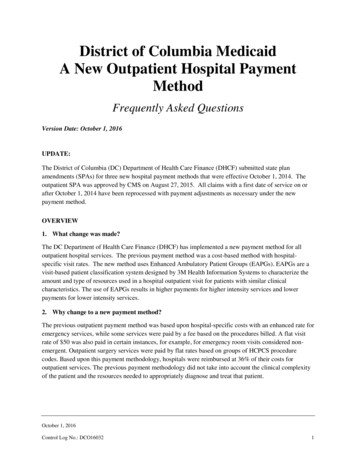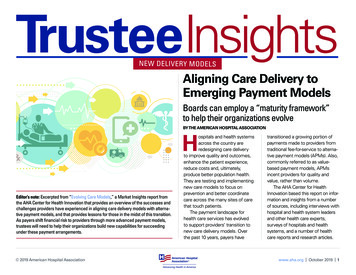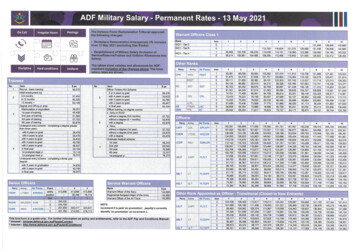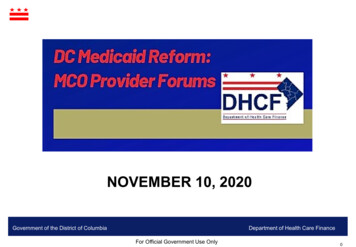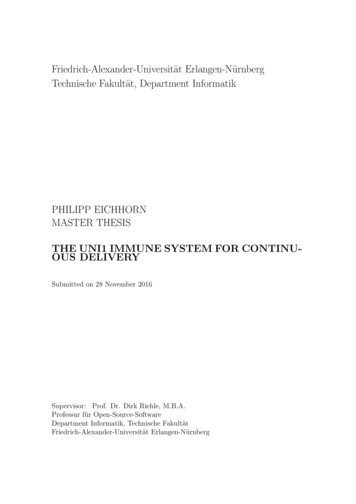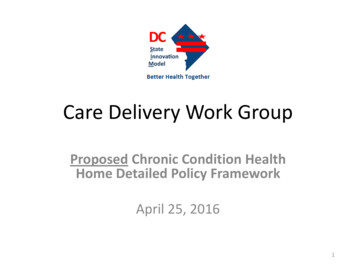
Transcription
Care Delivery Work GroupProposed Chronic Condition HealthHome Detailed Policy FrameworkApril 25, 20161
Health Home OverviewMODEL:ELIGIBILITY: Providers integrateand coordinate allprimary, acute,behavioral health,and long-termservices andsupports Have 2 or morechronic conditions Must include FFSand MCObeneficiaries CMS provides90/10 match forthe first 8 quarters*See Appendix B for definitionsREQUIREDSERVICES*: Comprehensivecare mgmt. Care coordination Have 1 chroniccondition and areat risk for a 2nd Have one SMI Health promotion Comprehensivetransitionalcare/follow-up Patient & familysupport Referral tocommunity &social supportservices2
Goals for Health Home 2 (HH2) Improve the integration of physical and behavioral health care Reduce healthcare costs– Lower rates of avoidable Emergency Department use– Reduce preventable hospital admissions and re-admissions Improve the experience of care and quality of services delivered Improve health outcomes3
Proposed HH2 Overview Target population: 25,000 beneficiaries ( 2/3 FFS) Eligibility: 2 or more chronic conditions; or 1 chronic condition &historical chronic homelessness (i.e., matched to DC’s PermanentSupportive Housing (PSH) program) Enrollment*: Patients will be assigned to a HH2 provider through anopt-out, with utilization trigger process. Patient attribution to HH2provider will be based on a prior provider/patient relationship (2year look-back), geography, provider capacity Target Start Date: January 2017*See Appendix A for enrollment/attribution process4
Proposed HH2-Eligible Chronic Conditions CMS Pre-Approved Health Home Chronic Conditions–––––Mental Health Condition (Depression; Personality Disorders)Substance Abuse DisorderAsthmaDiabetesHeart Disease (CHF; Conduction Disorders/Cardiac Dysrhythmias; MyocardialInfarction; Pulmonary Heart Disease)– BMI over 25 (DC using Morbid Obesity only) DC-Specific Chronic Conditions– Cerebrovascular Disease; Chronic Renal Failure (On Dialysis); COPD, Hepatitis;HIV; Hyperlipidemia; Hypertension; Malignancies; Paralysis; PeripheralAtherosclerosis; Sickle Cell Anemia Analysis based on:– Most common chronic conditions in DC;– Most common chronic conditions associated with high-cost beneficiaries; and– Chronic conditions amenable to care coordination5
Proposed Payment & Performance Metrics Payment Approach: PMPM; Triggered by the delivery of one of the six HH2 services. Therewill be an inactivity trigger if a HH2 service isn’t delivered over a certain time frame Payment Groups– Group 1 2 or more chronic conditions 46 PMPM 17,000 beneficiaries– Group 2 2 or more chronic conditions higher likelihood of future hospital utilizationbased on a risk assessment 137 PMPM 5,000 beneficiaries– Group 3 1 or more chronic condition Historical chronic homelessness (i.e., matchedto PSH program) Payment rate TBD 3,000 beneficiaries Pay-for-Performance: At a later date, a P4P element will be added for HH2 providers whomeet set metrics on readmission, preventable inpatient, avoidable ED utilization6
PMPM Rates from Chronic Condition HealthHomes or Comparable Program 160 137 140 130 120 103 100 76 80 60 59 42 46 40 24 20 13 10 9 12 0MissouriOregonIowaLowest TierAlabama WisconsinMaineMedicare DC Health(CCM)Home 2Highest (or Only) Tier7
Suggested HH2 Staff and Staffing RatioNurse Care ManagerGroup 1Group 21 FTE per every 400 enrolledbeneficiaries2 FTE per every 400 enrolledbeneficiaries2 FTE per every 400 enrolledbeneficiariesBachelor Social WorkerCommunity HealthWorker1 FTE per every 400 enrolledbeneficiaries3.5 FTE per every 400 enrolledbeneficiaries0.5 FTE per every 400 enrolledbeneficiariesClinical PharmacistHealth Home Director(Required)0.5 FTE per every 400 enrolledbeneficiaries0.5 FTE per every 400 enrolledbeneficiariesEstimated AverageDaily Patient Hours7.6 hours/day*8.4 hours/day*** Assumes 2 touches per month, 25 minutes per touch, 2 FTEs per 400 enrolled beneficiaries over 22 business days per month**Assumes 6 touches per month, 40 minutes per touch, 8.5 FTEs per 400 enrolled beneficiaries over 22 business days per month8
Comparison of Health Home Staffing RatiosDC(SMI)DC(ChronicConditions,Group 1)DC(ChronicConditions,Group 2)---1 to 6001 to 8001 to 8001 to 250---2 to 3001 to 4002 to 400---1 to 500---1 to 500------Behavioral HealthConsultant1 to 750---------------Bachelor SocialWorker/CareCoordinator1 to 7501 to 500---------2 to 400CommunityHealth Worker------------1 to 4007 to 800ClinicalPharmacist------------Team*1 to 1501 to 12511.25 to 2001.3 to land(SMI)HH Director1 to 2,5001 to 500Nurse CareManager1 to 250Primary CareLiaison* Team ratio doesn’t include HH Director--1 to 2001 to 8001 to 509
Proposed HH2 Payment MethodologyNurse Care Manager( 82,912)Group 1Group 2 17.27 34.55Bachelor Social Worker( 65,837)Community Health Worker( 40,224) 27.43 8.38Clinical Pharmacist( 144,036) 29.33 15.01Health Home Director( 104,125) 10.85 10.85Subtotal 36.50 117.17Admin/Overhead(13%) 4.75 15.23Health InformationTechnology 5 5Total 46.25 137.4010
Proposed HH2 Provider Standards A team of health care professionals embedded in the primary care and/or communitybased setting to effectively manage the full breadth of beneficiary needs and capable ofdelivering the 6 HH services. Achieve NCQA Level 2 recognition (or submission of application and achievement within12 months of program start date). Establish communication protocols with external partners, including legally compliantdata sharing agreements, to assure effective coordination and monitoring of enrollees’health care services. Offer 24/7 access to clinical advice (including appropriate services for beneficiaries withlimited English proficiency). Enroll in CRISP to receive hospital and ER alerts for enrolled individuals. Use a certified EHR to create and execute a person-centered care plan for each enrolledindividual based on HH assessments, hospital data and information gathered from otherexternal health care providers. Develop a plan to become more effective/improve past performance.11
Proposed HH2 HIE/Data Infrastructure Utilize a certified EHR. Enroll in CRISP to receive hospital event alerts. Pending federal funding, HHs will also have access to– A Dynamic Patient Care Profile tool; an “on-demand” document made available toMeaningful Use Eligible Providers and Eligible Hospitals, in addition to members of thecare team, that would display an aggregation of critical data (both clinical andadministrative) for a selected patient.– An Electronic Clinical Quality Measurement Tool and Dashboard, an electronic clinicalquality measurement tool to route inbound CCDs from eligible Medicaid hospitals andpractices to support required quality calculations and reporting; develop a populationlevel dashboard accessible by EPs and EHs for patient panel management.– An Analytical Patient Population Dashboard, also being developed with support fromIAPD funds to enable EPs and EHs to perform panel-level analysis on their associatedpatient populations. HHs are expected to share C-CDA or C-CDA equivalent structured data to one ofthe designated HIE entities in the District.12
Proposed HH2 MCO InteractionDHCFPMPM Paid Directly toProviderContract ModificationMCOHH2Delegation Agreement13
Components of HH2/MCO Delegation AgreementThe HH and MCO will establish an Memorandum of Understandingthat sets the communication frequency and protocol for:1) Identifying individuals receiving services from both entities;2) Developing a joint care plan for each shared individual, and clear division oflabor for executing the care plan, that is reflected in each entity’s respectivecare plan for each shared person;3) Outlining types of HH services delivered or that will be delivered to theshared individuals;4) Flagging each other on new information necessary for coordinatingservices, such as failure to pick up medication, recent housing status, newcommunity-based supports, and others.5) Establishing audit and program monitoring arrangements.6) The MOU will specify the point of contact for each entity.14
APPENDIX A
Proposed HH2 Attribution ProcessDHCF Runs Claims toDetermine EligibilityDHCF Auto AssignsPatients to a HHProvider’s PanelPayment triggeredwhen beneficiaryreceives first HH2 touchPayment can besuspended for inactivityor change in eligibilitystatusPatient Can Opt-OutPatient Can Switch HH2Providers16
HH2 Opt-Out w/ Utilization Trigger: AttributionDHCF runs claims quarterlyDHCF auto assignsbeneficiary based on pastexperience (2 year look back)with HH2 provider/geographyDHCF sends list to HH2provider of beneficiaries intheir panel; letter also goesto past providers and tobeneficiaryAttribution triggered whenbeneficiary receives first HH2service17
HH2 Opt-Out w/ Utilization Trigger: PaymentPayment triggered when provider submitsfirst HH2 claimHH2 provider receives a PMPM (prospective,unless status change/ inactivity)PMPM stops after 1 or 3 months of inactivity(based on group)18
HH2 Opt-Out w/ Utilization Trigger: InactivityPMPM can be suspended forinactivityGroup 1 inactivity No HH2service for a 3 month period;PMPM stops upon inactive statusGroup 2 and 3 inactivity No HH2service for a 1 month period;PMPM stops upon inactive statusPatient must receive newassessment annually, or morefrequently based on the discretionof the provider19
HH2 Opt-Out w/ Utilization Trigger: Status ChangePatient can be moved to adifferent tier due to status changeNo claims for an HH2 conditionover a 12 month period Nolonger eligible for HH2Risk score run quarterly for Group1 and Group 2Group 2 beneficiaries can bemoved to Group 1; andGroup 1 beneficiaries can bemoved to Group 220
HH2 Opt-Out w/ Utilization Trigger: Change ProviderHH2 Patient can opt-out or changeHH2 providerOpt-Out Provider uses modifieron claim to DHCF attesting thatthe HH2 eligible patient opted-outAlso, offer paper form option forpatientsAutomatically triggers a call fromDHCF to explain the program/steer them to new provider. After30 days, status is recorded inMMIS and patient is taken out ofHH2 panelChange Providers New providersends a form to DHCF attestingthat the HH2 eligible patient hasswitched providersStatus is recorded in MMISFormer HH2 provider notified;patient taken out of their panel21
APPENDIX B
Proposed Comprehensive CareManagement Definition Comprehensive care management (CCM) services address stages of health and disease tomaximize current functionality and prevent individuals from developing additional chronicconditions and complications, which includes a comprehensive needs assessment to determine therisks and whole-person service needs of individuals for HH team assignment, and lead the HH teamthrough the collection of behavioral, primary, acute and long-term care information from healthand social service providers to create a person-centered HH care plan for every enrolled individual.– HHs will use a strengths-based approach in developing the HH care plan that identifies thepositive attributes of the individual, which includes assessing his/her strengths andpreferences health and social services, and end of life planning; each HH team will update thecare plan for each empaneled individual– The HH team will monitor individual’s health status and progress toward goals in the care plandocumenting changes and adjusting the plan as needed.– The HH care plan is created and updated in the HH’s certified EHR, along with documentedactivities completed to create and maintain the HH care plan.23
Proposed Care Coordination Definition Care coordination is the implementation of the HH care plan through appropriate linkages,referrals, coordination and follow-up to needed services and support. Care coordination mayinvolve:– appointment scheduling and providing telephonic reminders of appointments;– telephonic outreach and follow-up to individuals who do not require face-to-face contact;– ensuring that all regular screenings are conducted through coordination with the primary careor other appropriate providers;– assisting with medication reconciliation;– assisting with arrangements such as transportation, directions and completion of durablemedical equipment requests;– obtaining missing records and consultation reports;– participating in hospital and emergency department transition care; and– documentation in the certified EHR.24
Proposed Health Promotion Definition Health Promotion services involve the provision of health education to the individual (and familymember/significant other when appropriate) specific to his/her chronic illness or needs asidentified in his/her HH care plan.– Assistance with medication reconciliation and provides assistance for the individual to developa self-management plan, self-monitoring and management skills and promotion of a healthylifestyle and wellness (e.g. substance abuse prevention; smoking prevention and cessation;nutrition counseling; increasing physical activity; etc.).– Health promotion also involves connecting the individual with peer/recovery supportsincluding self-help/self-management and advocacy groups, providing support for improving anindividual’s social network, and education about accessing care in appropriate settings.– HH team members will document the results of health promotion activities in the individual’scare plan, and ensure health promotion activities align with the individual’s stated health andsocial goals.– Each HH will use data to identify and prioritize particular areas of need with regard to healthpromotion; research best-practice interventions; implement the activities in group andindividual settings; evaluate the effectiveness of the interventions, and modify themaccordingly.25
Proposed Comprehensive TransitionalCare Definition Comprehensive transitional care includes the HHs efforts to reduce hospital emergencydepartment and inpatient admissions, readmissions and length of stay through planned andcoordinated transitions between health care providers and settings. HHs will:– Increase individual’s and family members’ ability to manage care and live safely in thecommunity, shifting the use of reactive or emergency care and treatment to proactive healthpromotion and self-management.– Automatically receive notifications of emergency room visits, admissions, discharges andtransfers (ADT) from hospitals as part of HHs’ enrollment in CRISP, and will outreach to thehospitals individuals related to these notifications to ensure appropriate follow-up care– Conduct in-person outreach when the individual is still in the hospital or call the individualwithin 48 hours of discharge.– Schedule visits for individuals with a primary care provider and/or specialist within one weekof discharge.– Have a clear protocol for responding to ADT alerts from hospitals or any other inpatient facilityto facilitate collaboration in treatment, discharge, and safe transitional care.– As part of consumer contacts during transitions, the HH will: a) review the discharge summaryand instructions; b) perform medication reconciliation; c) ensure that follow-up appointmentsand tests are scheduled and coordinated; d) assess the patient’s risk status for readmission tothe hospital or other failure to obtain appropriate, community-based care; and e) arrange forfollow-up care management, if indicated on the discharge plan.26
Proposed Individual and FamilySupport Definition Individual and family support services include all the ways a HH supports the individual and theirsupport team (including family and authorized representatives) in meeting their range ofpsychosocial needs and accessing resources (e.g. medical transportation; language interpretation;appropriate literacy materials; and other benefits to which they may be eligible or need).– Provide for continuity in relationships between the individual/family with their physician andother health service providers and can include communicating on the individual and family’sbehalf.– Educate the individual in self-management of their chronic condition; provide opportunitiesfor the family to participate in assessment and care treatment plan development; and ensurethat HH services are delivered in a manner that is culturally and linguistically appropriate.– Includes referrals to support services that are available in the individual’s community andassist with the establishment of and connection to “natural supports.”– Promote personal independence; assist and support the consumer in stressor situations;empower the consumer to improve their own environment; include the individual’s family inthe quality improvement process including surveys to capture their experience with HHservices; and allow individuals/families access to electronic health record information or otherclinical information.– Where appropriate, the HH will see the whole family as the client, developing family supportmaterials and services, including creating family support groups.27
Proposed Referral to Community andSocial Support Definition Referral to community and social support services provide individuals with referrals to a wide arrayof support services that will help them overcome access or service barriers, increase selfmanagement skills, and achieve overall health.– Facilitating access to support and assistance for individuals to address medical, behavioral,educational, social and community issues that may impact overall health.– The types of community and social support services to which individuals will be referred mayinclude, but are not limited to: a) wellness programs, including smoking cessation, fitness,weight loss programs; b) specialized support groups (e.g. cancer; diabetes support groups;etc.); c) substance treatment, support groups, recovery coaches, and 12-step programs; d)housing resources; e) social integration; f) financial assistance such as TANF or Social Security;g) Supplemental Nutrition Assistance Program; h) employment and educational program ortraining; i) legal assistance resources; and j) faith-based organizations.– HHs will assist in coordinating the services listed above and following up with individuals afterservices have been received.– The HH will develop and monitor cooperative agreements with community and social supportagencies in order to establish collaboration, follow-up, and reporting standards and providetraining and technical assistance as needed regarding the special needs of the population.28
Supportive Housing (PSH) program) Enrollment*: Patients will be assigned to a HH2 provider through an opt-out, with utilization trigger process. Patient attribution to HH2 provider will be based on a prior provider/patient relationship (2 year look-back), geography, provider capacity Target Start Date: January 2017


